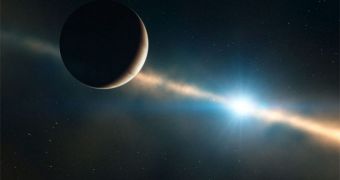One of the theories that astronomers had about how gas giants form says that the massive objects can appear around their parent stars when the cosmic fireballs are still very young. That is to say, as soon as the stars form, the planets appear, and then grow by accumulating gas. Though the idea was widely circulated, there has thus far been little proof to backup these claims. But, in a new study, researchers at the Universite Joseph Fourier in Grenoble, France, managed to snap the first images of a large exoplanet orbiting around its young star. The data proves once and for all that the previous theories were correct, Space reports.
According to the research team, the star in question is very young. They estimate its age to be about 12 million years, as opposed to our Sun, which is more than 4.7 billion years old. The exoplanet and its parent star are located towards the constellation of Pictor, some 60 light-years away from Earth. The fireball is called Beta Pictoris, the French team adds. In geological and astronomical terms, 12 million years is the blink of an eye, and so the experts were very surprised to find a fully-formed planet orbiting around such a young star. They say that the celestial body is about 75 percent more massive than the Sun, which may have contributed to allowing the gas giant to develop so quickly.
“According to theory we think giant planets can form in a few million years. This is a nice confirmation,” explains UJF expert and study researcher Gael Chauvin. The observations the team carried out also confirmed that the exoplanet orbits its star very closely, which is also an amazing discovery. For imaging the object and separating its spectra from that of its parent star, the French group used the Chile-based Very Large Telescope (VLT), which belongs to the European Southern Observatory (ESO). More specifically, they used one of the facility's 8.2-meter Unit Telescopes, which houses the NAOS-CONICA instrument. “For the first time we are really probing the birth of a planet inside the disk, which is really interesting,” Chauvin adds.
The young star is surrounded by a formation called a protoplanetary disk, which is basically an agglomeration of gas and dust, circling the newborn structure. Due to the gravitational pull of the star, and the disturbances that are caused in the disk, matter tends to clump together, and form increasingly-large bodies, such as rocks, meteorites, comets, asteroids, planets and gas giants. “We are pretty sure this is the way our solar system formed,” Chauvin argues. Details of the new investigation, which was lead by UJF researcher Anne-Marie Lagrange, appear in the June 11 issue of the top journal Science.

 14 DAY TRIAL //
14 DAY TRIAL //